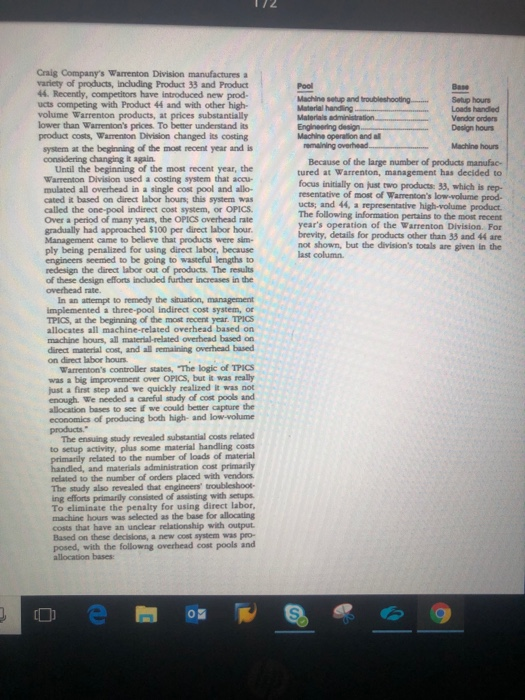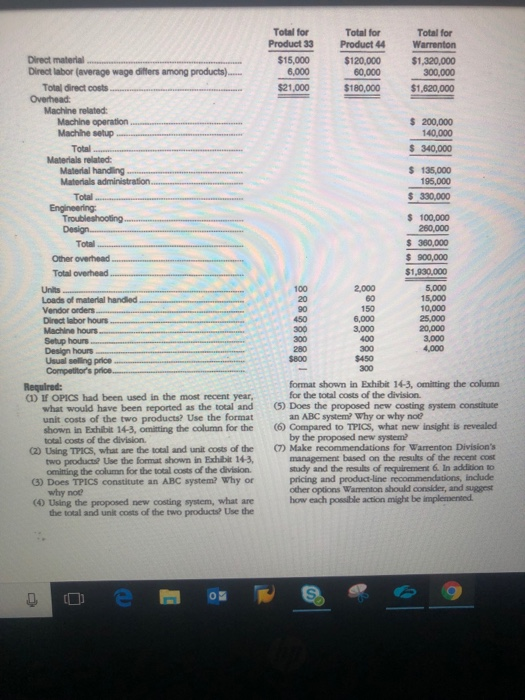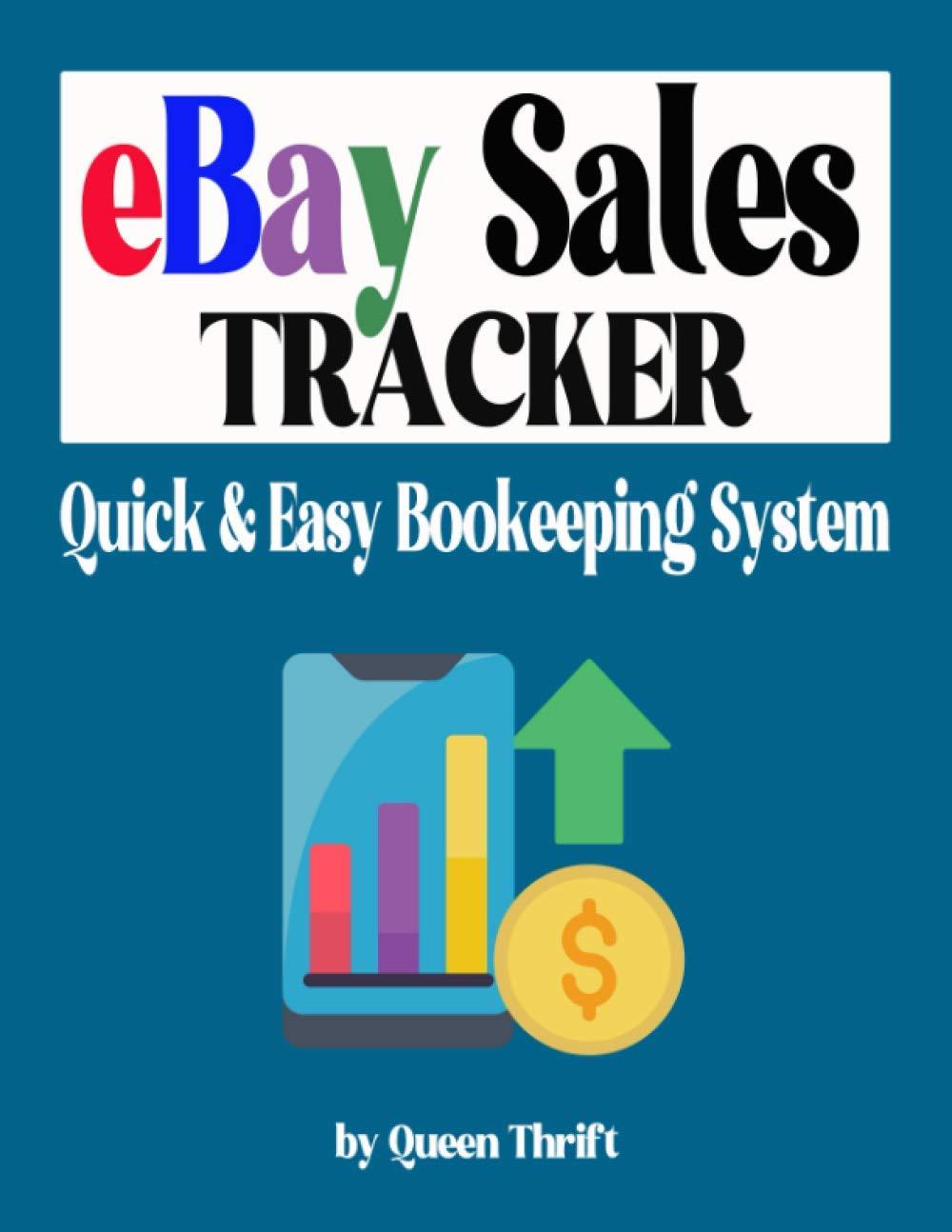this question is a cost accounting question, i need help with the required section on page 2 of this assignment
Craig Company's Warrenton Division manufactures a variety of products, including Product 33 and Product 44. Recently, competitors have introduced new prod- ucts competing with Product 44 and with other high- volume Warrenton products, at prices substantially lower than Warrenton's prices. To better understand its product costs, Warrenton Division changed its costing system at the beginning of the most recent year and is considering changing it again Until the beginning of the most recent year, the Warrenton Division used a costing system that accu- mulated all overhead in a single cost pool and allo- cated it based on direct labor hours; this system was called the one-pool indirect cost system, or OPICS Over a period of many years, the OPICS overhead rate gradually had approached $100 per direct labor hour Management came to believe that products were sim- ply being penalized for using direct labor, because engineers seemed to be going to wasteful lengths to redesign the direct labor out of products. The results of these design efforts included further increases in the overhead rate. In an attempt to remedy the situation, management implemented a three-pool indirect cost system, or TPICS, at the beginning of the most recent year. TPICS allocates all machine-related overhead based on machine hours, all material-related overhead based on direct material cost, and all remaining overhead based on direct labor hours Warrenton's controller states, "The logic of TPICS was a big improvement over OPICS, but it was really just a first step and we quickly realized it was not enough. We needed a careful study of cost pools and allocation bases to see if we could better capture the economics of producing both high- and low-wolume products The ensuing study revealed substantial costs related to setup activity, plus some material handling costs primarily related to the number of loads of material handled, and materials administration cost primarily related to the number of orders placed with vendors. The study also revealed that engineers' troubleshoot ing efforts primarily consisted of assisting with setups To eliminate the penalty for using direct labor, machine hours was selected as the base for allocating costs that have an unclear relationship with output Based on these decisions, a new cost system was pro- posed, with the followng overhead cost pools and allocation bases: Pool Base Machine setup and troubleshooting. Material handling. Materials administration. Engineering design Machine operatlion and all remaining overhead. Setup hours Loads handled Vendor orders Design hours Machine hours Because of the large number of products manufac- tured at Warrenton, management has decided to focus initially on just two products: 33, which is rep- resentative of most of Warenton's low-volume prod- ucts; and 44, a representative high-volume product The following information pertains to the most recent year's operation of the Warrenton Division. For brevity, details for products other than 33 and 44 are not shown, but the division's totals are given in the last column. Total for Product 33 Total for Product 44 Total for Warrenton Direct material $15,000 6,000 $120,000 60,000 $1,320,000 300,000 Direct labor (average wage differs among products).. Total direct costs Overhead Machine related Machine operation Machihe setup $21,000 $180,000 $1,620,000 $ 200,000 140,000 $ 340,000 Total Materials related: Material handling Materials administration. $135,000 195,000 $ 330,000 Total Engineering Troubleshooting Design. $ 100,000 260,000 $ 360,000 $ 900,000 Total Other overhead. $1,930,000 Total overhead 2,000 60 5,000 15,000 10,000 25,000 20,000 3,000 4,000 Units 100 20 Loads of materlal handled Vendor orders. Direct labor hours Machine hours 90 150 450 300 6,000 3,000 400 Setup hours Design hours Usual selling price Competitor's price. 300 280 $800 300 $450 300 format shown in Exhibit 14-3, omitting the column for the total costs of the division (5) Does the proposed new costing system constitute an ABC system? Why or why no? (6) Compared to TPICS, what new insight is revealed by the proposed new system? C7 Make recommendations for Warrenton Division's management based on the results of the recent cost study and the results of requirement 6. In addition to pricing and product-line recommendations, include other options Warrenton should consider, and suggest how each possible action might be implemented Required: (1) If OPICS had been used in the most recent year, what would have been reported as the total and unit costs of the two products? Use the format shown in Exhibit 14-3, omitting the column for the total costs of the division. (2) Using TPICS, what are the total and unit costs of the two products? Use the format shown in Exhibit 14-3, omiting the column for the total costs of the division 3) Does TPICS constitute an ABC system? Why or why noe (4) Using the proposed new costing system, what are the total and unit costs of the two products? Use the Craig Company's Warrenton Division manufactures a variety of products, including Product 33 and Product 44. Recently, competitors have introduced new prod- ucts competing with Product 44 and with other high- volume Warrenton products, at prices substantially lower than Warrenton's prices. To better understand its product costs, Warrenton Division changed its costing system at the beginning of the most recent year and is considering changing it again Until the beginning of the most recent year, the Warrenton Division used a costing system that accu- mulated all overhead in a single cost pool and allo- cated it based on direct labor hours; this system was called the one-pool indirect cost system, or OPICS Over a period of many years, the OPICS overhead rate gradually had approached $100 per direct labor hour Management came to believe that products were sim- ply being penalized for using direct labor, because engineers seemed to be going to wasteful lengths to redesign the direct labor out of products. The results of these design efforts included further increases in the overhead rate. In an attempt to remedy the situation, management implemented a three-pool indirect cost system, or TPICS, at the beginning of the most recent year. TPICS allocates all machine-related overhead based on machine hours, all material-related overhead based on direct material cost, and all remaining overhead based on direct labor hours Warrenton's controller states, "The logic of TPICS was a big improvement over OPICS, but it was really just a first step and we quickly realized it was not enough. We needed a careful study of cost pools and allocation bases to see if we could better capture the economics of producing both high- and low-wolume products The ensuing study revealed substantial costs related to setup activity, plus some material handling costs primarily related to the number of loads of material handled, and materials administration cost primarily related to the number of orders placed with vendors. The study also revealed that engineers' troubleshoot ing efforts primarily consisted of assisting with setups To eliminate the penalty for using direct labor, machine hours was selected as the base for allocating costs that have an unclear relationship with output Based on these decisions, a new cost system was pro- posed, with the followng overhead cost pools and allocation bases: Pool Base Machine setup and troubleshooting. Material handling. Materials administration. Engineering design Machine operatlion and all remaining overhead. Setup hours Loads handled Vendor orders Design hours Machine hours Because of the large number of products manufac- tured at Warrenton, management has decided to focus initially on just two products: 33, which is rep- resentative of most of Warenton's low-volume prod- ucts; and 44, a representative high-volume product The following information pertains to the most recent year's operation of the Warrenton Division. For brevity, details for products other than 33 and 44 are not shown, but the division's totals are given in the last column. Total for Product 33 Total for Product 44 Total for Warrenton Direct material $15,000 6,000 $120,000 60,000 $1,320,000 300,000 Direct labor (average wage differs among products).. Total direct costs Overhead Machine related Machine operation Machihe setup $21,000 $180,000 $1,620,000 $ 200,000 140,000 $ 340,000 Total Materials related: Material handling Materials administration. $135,000 195,000 $ 330,000 Total Engineering Troubleshooting Design. $ 100,000 260,000 $ 360,000 $ 900,000 Total Other overhead. $1,930,000 Total overhead 2,000 60 5,000 15,000 10,000 25,000 20,000 3,000 4,000 Units 100 20 Loads of materlal handled Vendor orders. Direct labor hours Machine hours 90 150 450 300 6,000 3,000 400 Setup hours Design hours Usual selling price Competitor's price. 300 280 $800 300 $450 300 format shown in Exhibit 14-3, omitting the column for the total costs of the division (5) Does the proposed new costing system constitute an ABC system? Why or why no? (6) Compared to TPICS, what new insight is revealed by the proposed new system? C7 Make recommendations for Warrenton Division's management based on the results of the recent cost study and the results of requirement 6. In addition to pricing and product-line recommendations, include other options Warrenton should consider, and suggest how each possible action might be implemented Required: (1) If OPICS had been used in the most recent year, what would have been reported as the total and unit costs of the two products? Use the format shown in Exhibit 14-3, omitting the column for the total costs of the division. (2) Using TPICS, what are the total and unit costs of the two products? Use the format shown in Exhibit 14-3, omiting the column for the total costs of the division 3) Does TPICS constitute an ABC system? Why or why noe (4) Using the proposed new costing system, what are the total and unit costs of the two products? Use the








